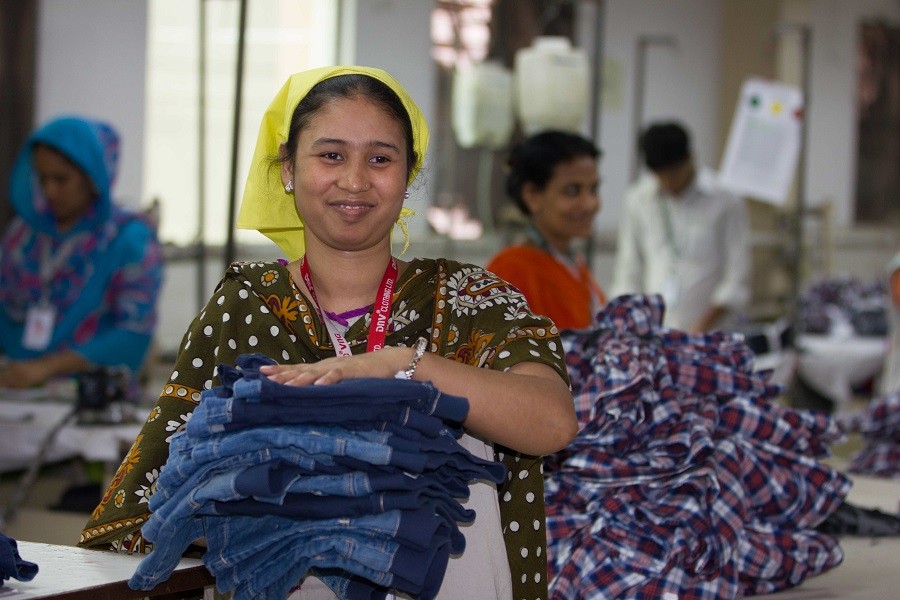Isn't it paradoxical that while global garment retailers insist on transforming garment factories into green production units at substantial costs, there is yet no sign of even a marginal hike in the prices? Since the incidents of Tazreen fire in November 2012 and Rana Plaza building collapse in April 2013 that shook the entire garment industry with potential threats for the future, the country's readymade garment factories have undergone large-scale renovation works to ensure safety of the workers. The two representative agencies of international buyers - the EU-based Accord and North America-based Alliance, along with local inspection agencies, have successfully accomplished the task of factory remediation in respect of about 80 per cent of the 5000 garment factories-mostly located in Dhaka and Chottogram.
Accompanying the factory remediation works, there have been a lot of proactive moves by a good number of large factory owners in that they advanced far ahead turning their factories into what is dubbed as green factories. This involves a major shift in energy and environmental design of the factories and significant investment in eco-friendly production processes. In a short time, surprisingly indeed, the country topped the list of garment-producing countries in respect of the number of full-fledged green factories.
The factories received Leadership in Energy and Environmental Design (LEED) certificate from the United States Green Building Council (USGBC). A LEED-certified factory ensures 25-30 per cent less water and energy consumption, and fewer industrial accidents, like fire.
Reports say that around 70 garment factories have received LEED certification from USGBC. Another 280 factories are in the process of getting LEED certification. Among all the exporting countries taken together, Indonesia's position is next to Bangladesh with 50 LEED certified garment factories.
With things better positioned than ever in the past, it was expected that international buyers, now free from the indictment of procuring from unsafe and hazardous production places, will pay a little extra while placing orders to these state-of-the-art factories. Unfortunately, this is not happening. A local daily recently reported that green garment factory owners, who spent huge amounts for setting up these units, are dismayed as their efforts are not being rewarded by international retailers by way of higher prices. Construction cost of these factories is estimated to be 20-30 per cent higher than the regular ones because of the special design and introduction of newer technologies.
It may be noted that consumers in the developed world, backed by consumer rights protection groups, make it a strong point that products like garments, footwear etc must not be sourced from countries where workers are ill paid and working condition is unsafe. It may be recalled that soon after the Rana Plaza collapse, there was a move in the West, led by the consumer rights protection groups, to boycott garments sourced from Bangladesh.
This, however, didn't happen thanks to the gigantic task of factory remediation taken up by the factory owners under the initiative of Accord and Alliance. The industry, which looked like tumbling in the face of adverse propaganda, did succeed to ride out the bad time.
It is well known that at the beginning when Bangladesh started exporting readymade garments to North America and the European Union (EU) in the early eighties, prices offered were bare minimum. This, understandably, was because of low wage and relatively low cost in installing factories many of which were not in harmony with international standards. Besides, the country -- a new entrant to the competitive global apparel market -- was not in a position to bargain for reasonably higher prices. On the other hand, retailers aware of the weaknesses of the factories, often exposed to risks including life threatening ones in many cases, were not much concerned in so far as their procurement went hassle-free, that too at meagre prices. The situation is entirely different now. While initially, the factories were mostly engaged in low-end bulk products, over time many of them have moved to the high-end segments of apparel products.
A comparative picture of prices of some basic apparel products, published in a local newspaper, shows that Bangladeshi exporters are no where near their competitors in getting paid for their merchandise. One argument could be the exporters' eagerness to remain busy round the year at the expense of less than deserving price, which some of them might consider a lesser evil than sitting idle for a month or so despite being paid higher prices. This is because businesses at times have no choice but to resort to practices under constraints only to stay in business. But, for how long?
This is a reality that must not be ignored by the retailers. After all, sourcing from a ramshackle factory can not be matched with that from a state-of-the-art one. There should also be concerted efforts from the industry to bring home this point. Recently, there were moves from the garment workers' unions for wage hike, and although a minimum wage has been set, it is far below the wage structure demanded by the workers and endorsed by rights groups, civil society and the media. The owners' argument that raising workers' wage is contingent on fair price of their products can not be sensibly dismissed as a dull excuse.
Given the situation, it is time the country got rid of the disrepute of being dubbed as the cheapest source of garment procurement.


